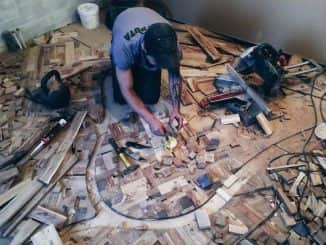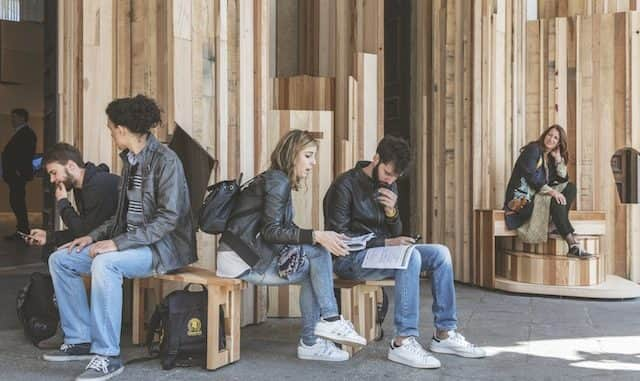
Too Good to Waste seeks to question the validity of the current relationship between wood consumption and fashion
Too Good to Waste – an interactive installation designed by Benedetta Tagliabue of EMBT, crafted by furniture makers, Benchmark and initiated by the American Hardwood Export Council for Interni’s Material Immaterial exhibition was opened on April 3, 2017 at the Università degli Studi di Milano. On display until April 15 as part of Salone del Mobile Milano 2017, the bold timber installation comprises four individual and unique pieces, wrapped around the statuesque pillars of the entrance to the Aula Magna auditorium, transforming at the hand of visitors to reveal hidden pieces of fine furniture.
“I feel very privileged to be designing an installation with American hardwoods and Benchmark’s craftsmanship in wood, which is presented in Milan, the city where I was born and raised,” said Benedetta Tagliabue, founder of EMBT. “We wanted to re-create this concept in a playful and modern way by creating a wall full of surprises, where the people who inhabit the wall will be real. We hope that visitors, surprised by this installation, will want to interact with it, and that they will discover and use the pieces of furniture it hides: seats, tables, mirror. We hope that their curiosity will make this piece very animated.”
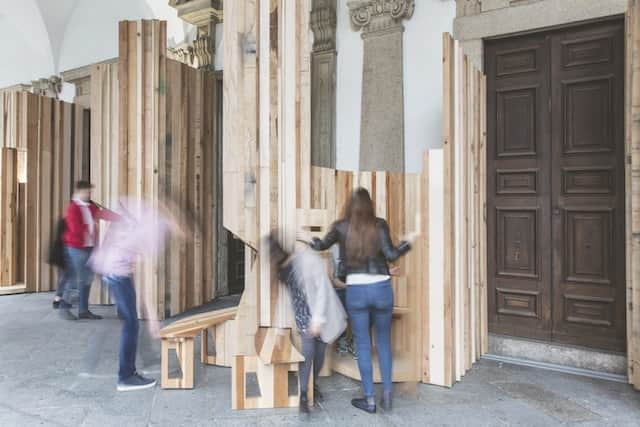
Made from American red oak, soft maple, cherry and tulipwood, Too Good to Waste seeks to question the validity of the current relationship between wood consumption and fashion. Contrary to popular perception, not all forests are disappearing. In fact, the vast American hardwood forest is a quickly expanding resource and the volume of its standing timber has more than doubled in the last 50 years. However, due to fashion and color trends, demand is too often focused on just a few species, while many others are underused or left in the forest, which is a lost opportunity for both design and carbon storage.
According to AHEC, Too Good to Waste is an invitation to reflect on the responsible use of these forests and to discover species and grades of American hardwoods rarely found in homes or furniture stores in Europe, but that need to be considered if we want to contribute to a balanced and sustainable use of the forest. The physical form of the installation shows the transformation of hardwood from its rawest form into the fine finish of cabinetry, expressing how furniture ultimately comes from the forest.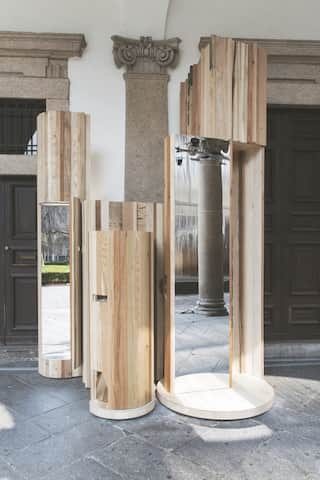
In the words of Sean Sutcliffe, who co-founded Benchmark with British design legend Terence Conran, “Too Good to Waste is about using the forest to its effective maximum. We are using species that are not getting the value they should and we are using them to show that they are beautiful, versatile and useful woods for craftsmen. The second thing we are addressing is the grading issue; we, as picky cabinet-makers, have always been very fussy about using the best bits and that needs to change if we are to move to a more sustainable way of living. We are now using knots, sapwood and all sorts of character that 10 years ago would have been unthinkable in high end furniture. So here we are showing the grades of hardwood, that wouldn’t be used normally in joinery or furniture, and we are expressing it in a way that says This is beautiful, look, it is too good to waste!”
Given that many wood products currently available are limited to certain colors and hardwood species, it is depriving consumers and designers the freedom and excitement to experience what comes from using much more of the material that is available. Through this project, AHEC is tapping into an important concept that’s very relevant in today’s society: how to make more use of materials that may not be our first choice in order to be more sustainable? This project aims to open a dialogue on these topics.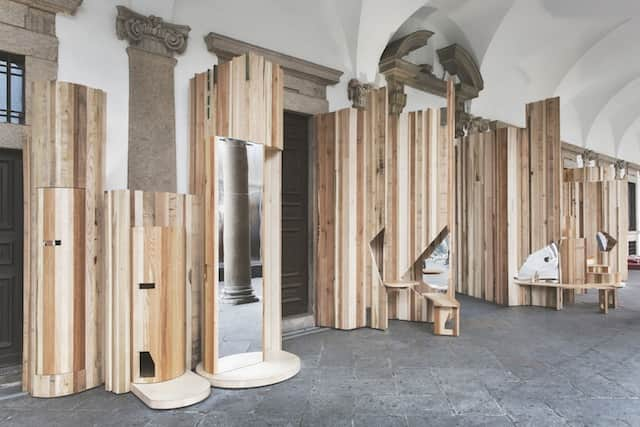
This project is not only a celebration of all the variety of species and grades of hardwood that the forest naturally produces and regenerates, but also an invitation to discover the piece in the most literal sense: users are encouraged to touch and inhabit this piece, to interact and play with it, opening its different components by pushing, pulling, swiveling and discovering new configurations. Too Good to Waste reimagines the historic architecture of the Cortile d’Onore (the courtyard from the Renaissance period by the famous architect Filarete where the piece is located), which features many decorative elements and human figures coming out of the walls.
“We have built a woodland from rough sawn vertical planks of American tulipwood, cherry, red oak and maple and out of this woodland we are drawing finished pieces of furniture. We have kept the vertical stripes of the forest and extended them into the furniture, transforming them from the raw state of the tree trunks into the polished finish of the cabinet maker. Particularly interesting is how this installation elegantly expresses that furniture comes from the woods, a direct relationship that people don’t always make,” adds Sutcliffe.
“Imperfection can make a piece completely beautiful and unique and I hope this project will convey the message that you can work with materials that are considered imperfect and with skills, intelligence and curiosity you can transform them into something beautiful, unique and beloved,” concludes Tagliabue.
About AHEC
The American Hardwood Export Council (AHEC) is the leading international trade association for the U.S. hardwood industry, representing the committed exporters among U.S. hardwood companies and all the major U.S. hardwood production trade associations. AHEC runs a worldwide programme to promote American hardwoods in over 50 export markets, concentrating on providing architects, specifiers, designers and end-users with technical information on the range of species, products and sources of supply. In addition, AHEC also produces a full range of technical publications. For more information, please visit: www.americanhardwood.org.
About Benedetta Tagliabue
Benedetta Tagliabue studied architecture at the Istituto di Architettura di Venezia (IUAV) and currently act as director of the international architecture firm Miralles Tagliabue EMBT, founded in 1994 in collaboration with Enric Miralles, based in Barcelona and, since 2010, in Shanghai. Among her most notable projects built are the Edinburgh Parliament, Diagonal Mar Park, the Santa Caterina market in Barcelona, Campus Universitario de Vigo, and the Spanish Pavilion at the 2010 Shanghai World Expo which was awarded the prestigious RIBA International ‘Best International Building of 2011’ award.
Current studio projects include the Business School of Fudan University in Shanghai, office towers in Xiamen and Taichung, public spaces of HafenCity in Hamburg Germany, the metro station Clichy-Montfermeil in Paris, France (first prize in competition) and the metro central station in Naples, Italy. Her award-winning studio works in the fields of architecture, design of public spaces, rehabilitation, interior and industrial design.
In the teaching field, she has also been a visiting professor at Harvard University, Columbia University and Barcelona ETSAB, lecturing regularly at architecture forums and universities, and is part of jurors around the world, e.g. the Princesa de Asturias awards and the jury of
the Pritzker Prize. Her work received the RIBA Stirling Prize in 2005, the National Spanish Prize in 2006, the Catalan National prize in 2002, City of Barcelona prize in 2005 and 2009, FAD prizes in 2000, 2003 and 2007.
She is also the director of the Enric Miralles Foundation, whose goal is to promote experimental architecture in the spirit of her late husband and partner Enric Miralles. For more information, please visit: www.mirallestagliabue.com.
About American red oak (Quercus spp.)
Red oak is the dominant species in the U.S. hardwood forests with distinctive grain and wood that is not always red in color. The name is supposedly due to the Autumn leaf color. Red oak trees grow only naturally and almost exclusively in North America, although planted elsewhere. Forest Inventory Analysis (FIA) data shows red oak growing stock is 18.7%of total U.S. hardwood growing stock and that while 33.9 million m3 of American red oak are harvested each year, more than 32 million m3 are naturally growing over the same period. In general, the sapwood of red oaks is light brown and the heartwood is often pinkish to reddish brown. American red oaks have very good overall strength properties relative to weight. Its main uses are furniture, flooring, doors and certain construction applications.
About American cherry (Prunus serotina)
American cherry is a supreme species from the U.S. hardwood forests and is unique to North America, with warm color tones and superb finishing qualities. Forest Inventory Analysis (FIA) data shows U.S. cherry growing stock is 3.0% of total U.S. hardwood growing stock and that while 4.3 million m3 is harvested each year more than 11 million m3 of American cherry is growing naturally across the U.S. forests during the same period. The heartwood of cherry can vary from rich red to reddish brown and darkens on exposure to light with time. The sapwood is creamy white. Being hard and stable when dry, the wood is very easy to stain and finish to an excellent surface. It is highly prized for furniture and interior joinery.
About American maple (Acer spp.)
Growing naturally in the hardwood forests of North America, the American maples, comprising soft maples and hard maples, are amongst the most prolific and sustainable species. Both types of maple are similar in appearance, with a creamy white sapwood and a light to dark reddish brown heartwood. Maples grow widely across the eastern USA, with hard maples favoring the colder growing conditions of the Northern Sates. Forest Industry Analysis (FIA) data shows U.S. maples make up 17.9% of total U.S. hardwood growing stock and while 23.9 million m3 is harvested each year, in the same time period there is natural growth in the forest of nearly 55 million m3. Maple wood is generally straight grained with a fine texture and can be stained and polished to produce a high quality smooth finish. Both maples are ideal materials for furniture, cabinet making and joinery, although the hardwearing properties of hard maple make it more suitable for flooring.
About American tulipwood (Liriodendron tulipifera)
American tulipwood is one of the most prolific species from the U.S. hardwood forests and is unique to North America. Forest Inventory Analysis (FIA) data shows U.S. tulipwood makes up 7.7% of total U.S. hardwood growing stock and while 12.8 million m3 are harvested each
year, more than 32 million m3 of American tulipwood grows naturally in the hardwood forests every year. Tulipwood has less strong grain characteristic than species such as ash and oak and exhibits a marked difference between the sapwood and heartwood. The sapwood is creamy white whereas the heartwood can vary from pale yellow or brown to green and purple in extreme cases. The wood darkens on exposure to light. Tulipwood has extraordinary overall strength properties relative to weight, making it highly suitable for structural applications, such as glue-laminated beams and cross-laminated timber (CLT).
About Benchmark
Benchmark is one of the UK’s leading furniture makers, founded 30 years ago by Terence Conran and Sean Sutcliffe. ‘Too Good to Waste’, conceived and delivered in just seven weeks, is a fine example of Benchmark’s design resolution skills and ‘can-do’ attitude. It is the scale of their workshops and the skills of their designers and craftsmen that has enabled the vision of EMBT and AHEC to become a reality.
With one of the country’s most technologically advanced workshops and a team of over 50 craftsmen and designers, Benchmark design and make furniture that combines contemporary technologies and values with traditional craftsmanship and high quality materials to last for generations. Twice winners of the Queen’s Award for Enterprise in Sustainable Development, their sustainable credentials are second to none.
With significant breadth of experience, Benchmark make furniture for workspaces, hotels, restaurants, retail, public buildings and private residences. As well as making for contemporary spaces, their furniture graces many heritage buildings including cathedrals, Oxbridge colleges, schools, museums and libraries. Benchmark’s expertise extends well beyond the UK with extensive work in Europe including projects in Paris, Berlin, Milan, Frankfurt, Hamburg and Madrid as well as further afield into North America, Middle East, Asia Pacific and Japan. For more information, please visit: www.benchmarkfurniture.com.

